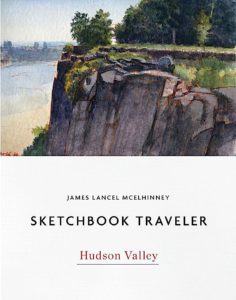Battling the COVID-19 pandemic, we all patiently wait for the crisis to pass, including many dear friends everywhere who are sheltering in place. Almost a week ago I published the first in a series of daily website blog-posts, of writings and artworks that celebrate personal mobility, in pursuit of mindful engagements with history, nature and the environment. In relation to a finished painting, or an essay, this process is no less a work of art than is the tree to the fruit it bears. In a sense, this practice may be ceremonial, acts of reverence, in beholding the world around us. Offered as messages of hope and solidarity, these posts will appear every day, until these dark days are behind us.

Fort Wool, Hampton Roads, Virginia. Completed July 20, 1992. Oil on canvas. 22 x 50 inches. Private collection
In February 1991, I moved from Philadelphia to Richmond Virginia. For the next three years, I researched, explored, and painted Civil War sites, which I saw as physical memories of past conflicts, and thus symbolic of how the American landscape is a shaped by an ongoing quarrel about what it is. The following is drawn from my journals.
July 10, 1992. Fort Wool. Rip-Raps Island. Hampton, Virginia. 4 pm.
My headache returns, now worse than before. Because the painting is going so well. I soldier on. Watching all the pieces fall into place, something tells me that I might be pushing myself too hard. Feeling slightly disoriented. I dump water over my wrists and head. What remains in the bottle soaks a handkerchief, which I fold up and place on my head, under my straw Amish hat.
The heat has become nearly unbearable. Landing twenty yards away, a gull jumps up with a squawk, taking flight. So hot was the concrete. Through the din of harbor-traffic, motorboat engines, bridge-traffic, public-address announcements drifting across the water from Fortress Monroe, I hear something else. Unable at first to identify the sound, I hear the haunting wail of bagpipes.
Am I losing my mind? Should I call down for help?
In my attempt to dismiss the hallucination, I envelope myself in silence through sheer force of will. The music only grows louder. Chills run down my spine. Sweat stings my eyes. Just then I hear something else–low and steady, splashing and rumbling.
Looking to my right two hundred yards off, a grey form slices the waves. Standing at attention, dressed in their whites, crewmen line the port rail. Alone on the bridge stand a sailor. Straight as a ramrod, hands in front, his fingertips work on the chanter. The bladder is tucked up under his arm. Drones bristle above his left shoulder. Playing a tune we all know so well, it nearly lays me flat. John Newton’s hymn of shame and salvation, Amazing Grace pierces the air. Seabirds glide on warm breezes. A warship slips past us, on its way home.
Postscript: My painting of Fort Wool in 1998 was included in the exhibition Sacred Sites, curated by Brooks Johnson at the Chrysler Museum in Norfolk, Virginia, where it hung alongside Edouard Manet’s 1864 painting, The Battle of the Kearsarge and Alabama, in the collection of the Philadelphia Museum of Art. Growing up in the Delaware valley, I often visited the museum. Manet’s painting was always one of my favorites.

The Battle of the Kearsarge and Alabama. 1864. Collection Philadelphia Museum of Art
(A preview of SKETCHBOOK TRAVELER by James L. McElhinney (c) 2020. Schiffer Publishing).
Copyright James Lancel McElhinney (c) 2020 Texts and images may be reproduced (with proper citation) by permission of the author. To enquire, send a request to editions@needlewatcher.com
